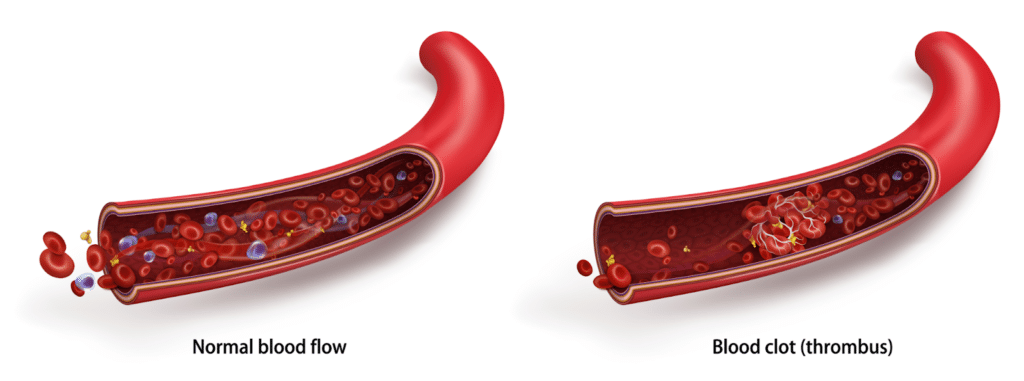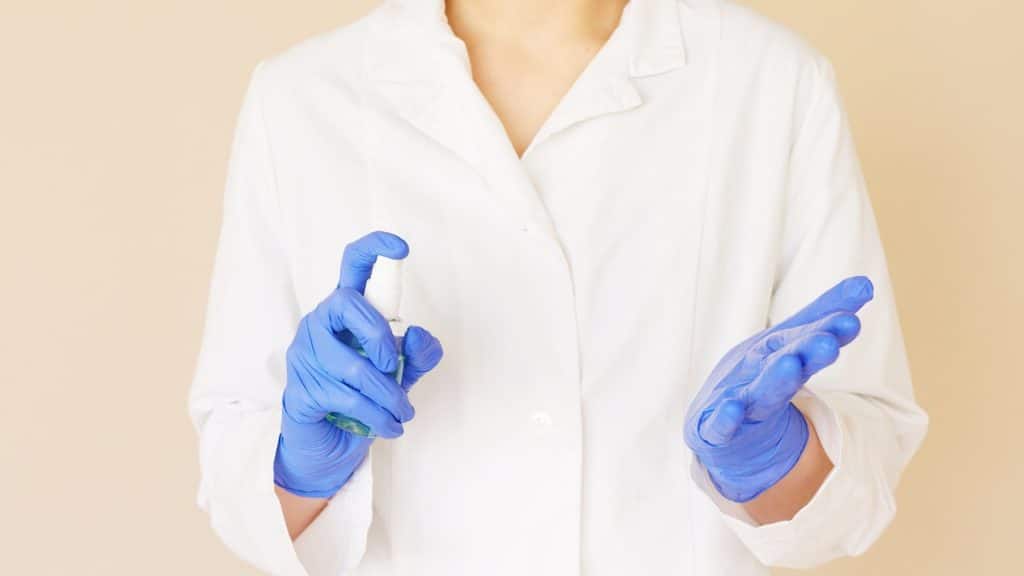
As a result six patients recently experiencing blood clots after their Johnson & Johnson COVID-19 vaccine, the vaccine has been temporarily pulled from being administered, and many of our patients are wondering if they should be worried, and ultimately if they and their loved ones should get vaccinated. While we’ve all struggled through the many ups and downs and unknowns over the last year, many have hit their height of fear when it comes to this question.
The questions we’re hearing from patients at St. Louis Laser Vein are particularly concerned about Deep Vein Trombosis (DVT) and the potential for experiencing this as the result of being vaccinated. Below we highlight the safety of these vaccines in this area, but even more importantly, we emphasize that the risk of DVT is far higher if a patient contracts COVID-19, which the vaccination can help prevent.
Most people think of COVID-19 as respiratory disease, but it’s truly a vascular disease. The way COVID-19 damages the lungs is through an attack on the endothelial cells – the cells that line the vessels in our body. A protein in COVID-19 attaches to what’s called the ACE 2 Receptor, which lines our arteries and veins. When this happens, the virus causes damage to the Mitochondria and other vital structures, leading to lung damage, heart attacks, strokes, and blood clots which may lead to Deep Vein Thombosis.
What is Deep Vein Trombosis?
Deep vein trombosis is a very serious condition caused when a blood clot forms in a vein that is located deep inside your body. This blood clot is a cluster of blood that’s solidified, similar to the blood you see clotting and beginning to harden when you have a cut or scratch. Clots can be caused by damaged blood vessel walls that narrow and block blood flow and cause clumping, but it can also be the result of damaged vessels from surgery, the lack of body movement for long periods of time, or other personal medical conditions that affect efficient and healthy blood flow.

Whatever the reason for the blood clot formation, ultimately it becomes a problem when it blocks the vein deep in your body and prevents blood from being able to properly circulate. This can cause extremely serious and dangerous medical conditions, such as a pulmonary embolism. In this case, the clot moves from one location, such as the arm or leg, and into the lung. Once the clot begins to block vessels in the lungs, the condition can become life-threatening.
These blood clots in deep veins are usually seen in the legs, particularly in the thigh or lower leg. However, they can develop in other areas of the body as well. The Center for Disease Control and Prevention (CDC) notes that about half of those who have DVT will experience symptoms, while the other half will be unaware of their condition. For this reason, many patients who know they have vein issues have become worried about vaccination. Symptoms may be different based on the area of the clot.
For example, lower body DVT can include symptoms like swelling in the extremities (usually the foot, ankle, or leg on one side of the body), cramping, unexplained foot or ankle pain, skin that’s warm to the touch (and warmer than the surrounding skin), or the skin changing colors from turning pale, or to a blue or red color.
Upper body DVTs are less common, but like the lower body experiences, not all patients will know they have a clot, and may or not experience symptoms. Examples of upper body DVT symptoms include neck or shoulder pain, swelling in the arm or hand, blue-colored skin, pain that moves up and down from the forearm to the arm, or experience weakness in one or both of their hands.
Should I be worried about DVTs and the COVID-19 Vaccine?
While DVTs can be serious and concerning, the good news is that the COVID-19 vaccines have extremely low risks of blood clots and DVTs. As of April 25, 2021, the CDC recommends the use of Johnson & Johnson Janssen (J&J/Janssen) COVID-19 vaccine be resumed. They highlight that the “reports represent a reporting rate of 7 such events per 1 million vaccinations among women 18 through 49 years old and a rate of 0.9 per 1 million vaccinations among women 50 years and older. For all women, this is a rare adverse event. For women 50 years and older and men of all ages, the adverse event is even rarer. Reports show that symptoms of this adverse event started between 6 and 15 days after vaccination.”
While the risk of DVTs while getting the J&J vaccine are 7 in 1 million if you’re under 49, and .9 in 1 million otherwise, the risk of DVTs if you contract COVID-19 are exponentially higher and more dangerous.

The American Journal of Medicine and Physical Rehabilitation recently published a medical study focused on the prevalence of DVTs in COVID-19 patients. They highlight that while DVT has already become known to be an early complication of COVID-19, they note that there have been a considerable number of occurrences that were diagnosed during the weeks after acute hospital admission including after hospital discharge, revealing that DVTs may arise in any phase of COVID-19. So, while the J&J vaccine reports extremely low risk, and with a risk window within approximately the first two weeks after vaccination, the prevalence and time period of this risk after contracting the virus is exponentially larger.
Even more troubling, the study references one autopsy study of 12 consecutive COVID-19–positive deaths that revealed DVT in 58% of the patients. In their own study, a lower limb deep venous thrombosis was diagnosed in 22% (25/113) of the patients tested, with eight patients (7.1%) having a proximal deep venous thrombosis. Risk factors for screening positive for a deep venous thrombosis included being male, younger, and has been on a ventilator during the acute illness. Comparatively, so far, the J&J vaccine recipients to experience DVTs have all been women between 18 and 49.
The high rate of deep venous thrombosis observed in these patients suggests that the risk of venous thromboembolic disorders after severe COVID-19 illness is considerable and surveillance measures of such patients should be undertaken. This study reports a high rate of lower limb DVT in asymptomatic patients admitted to an IRH with a diagnosis of COVID-19 and strongly suggests greater surveillance of such patients.
There’s a Greater Risk of Deep Vein Thrombosis if you don’t get vaccinated!
Ultimately, the data and study of prior patients give us the answer we need to feel confident and safe getting the COVID-19 vaccination. The J&J vaccine has been recommended to be instituted by the CDC as of April 25, 2021, and the American Journal of Medicine and Physical Rehabilitation compiled a comprehensive list of prior studies (plus conducted their own) that emphasize and further prove that the risk of DVTs is over 50% in some instances, and can occur at any stage of being infected with COVID-19. On the other hand, the J&J vaccine risks of DVT are within the first two weeks post-vaccination (approximately), and at maximum risk of 7 in one million vaccinations. Contact us now!

